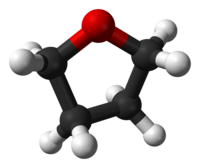
Photo from wikipedia
Lignin-based polyol was obtained via oxyalkylation reaction with propylene carbonate using eucalyptus kraft lignin isolated from the industrial cooking liquor by the Lignoboost® procedure. This lignin-based polyol (LBP) was used… Click to show full abstract
Lignin-based polyol was obtained via oxyalkylation reaction with propylene carbonate using eucalyptus kraft lignin isolated from the industrial cooking liquor by the Lignoboost® procedure. This lignin-based polyol (LBP) was used without purification in the preparation of polyurethane (PU) adhesives combined with polymeric 4,4′-methylenediphenyl diisocyanate (pMDI). A series of adhesives were obtained by varying the NCO/OH ratio of PU counterparts (pMDI and LBPs) and their performance was evaluated by gluing wood pieces under predefined conditions. The adhesion properties of the novel PU adhesive were compared with those of a commercial PU adhesive (CPA). The occurrence and extent of curing reactions and changes in the polymeric network of PA were monitored by Fourier transform infrared spectroscopy (FTIR) and dynamic mechanical analysis. Although the lap shear strength and glass transition temperature of the lignin-based PU adhesives have increased steadily with the NCO/OH ratio ranging from 1.1–2.2, chemical aging resistance can be compromised when the NCO/OH is very low. It was found that the lignin-based PU adhesive with an NCO/OH ratio of 1.3 showed better chemical resistance and adhesion efficiency than CPA possibly because the NCO/OH in the latter is too high as revealed by FTIR spectroscopy. Despite some lower thermal stability and shorter gelation time of lignin-based PU than CPA, the former revealed great potential to reduce the use of petroleum-derived polyols and isocyanates with potential application in the furniture industry as wood bonding adhesive.
Journal Title: Polymers
Year Published: 2022
Link to full text (if available)
Share on Social Media: Sign Up to like & get
recommendations!